University Name: CBM200 Literature Review on Myanmar Tourism
VerifiedAdded on 2022/09/14
|7
|1685
|21
Literature Review
AI Summary
This literature review examines the state of sustainable tourism development in Myanmar, focusing on the period after the country's opening to the outside world in 2011. It highlights the rapid growth of tourism, its positive economic impacts (such as job creation and contribution to GDP), and the associated negative environmental consequences. The review defines sustainable tourism according to the World Tourism Organization and United Nations Environment Program, outlining key indicators like eco-tourism, sustainable travel, community involvement, and minimizing carbon footprint. It discusses the Myanmar Responsible Tourism Policy 2012 and government initiatives to promote eco-tourism, including activities in the Myeik Archipelago and efforts to preserve cultural heritage sites like Bagan and Indawgyi Lake. The review also addresses challenges such as infrastructure deficits, labor shortages, and waste management, emphasizing the need for destination management organizations (DMOs) and awareness programs to ensure sustainable growth. The author references a variety of academic sources to support their claims.
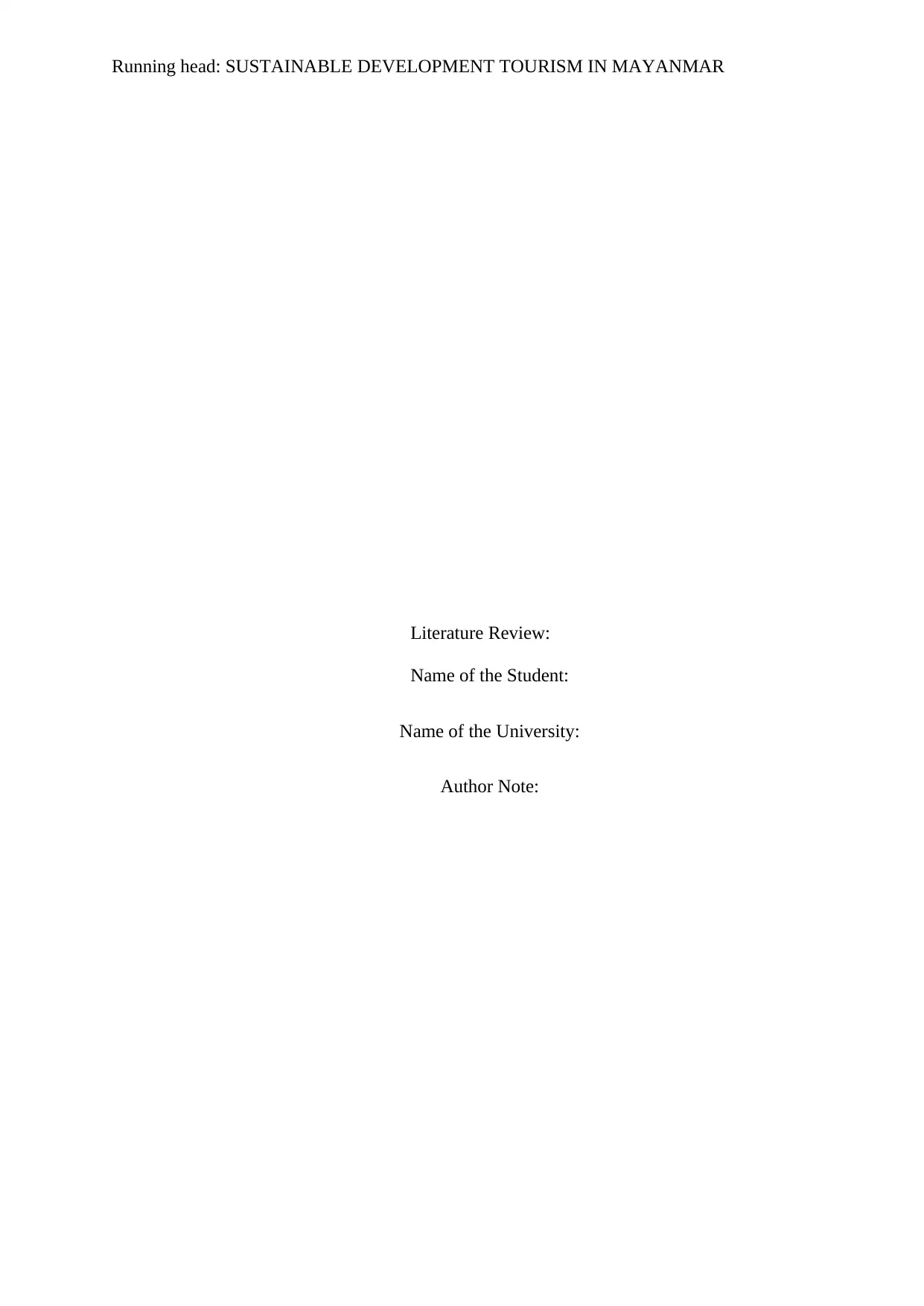
Running head: SUSTAINABLE DEVELOPMENT TOURISM IN MAYANMAR
Literature Review:
Name of the Student:
Name of the University:
Author Note:
Literature Review:
Name of the Student:
Name of the University:
Author Note:
Paraphrase This Document
Need a fresh take? Get an instant paraphrase of this document with our AI Paraphraser
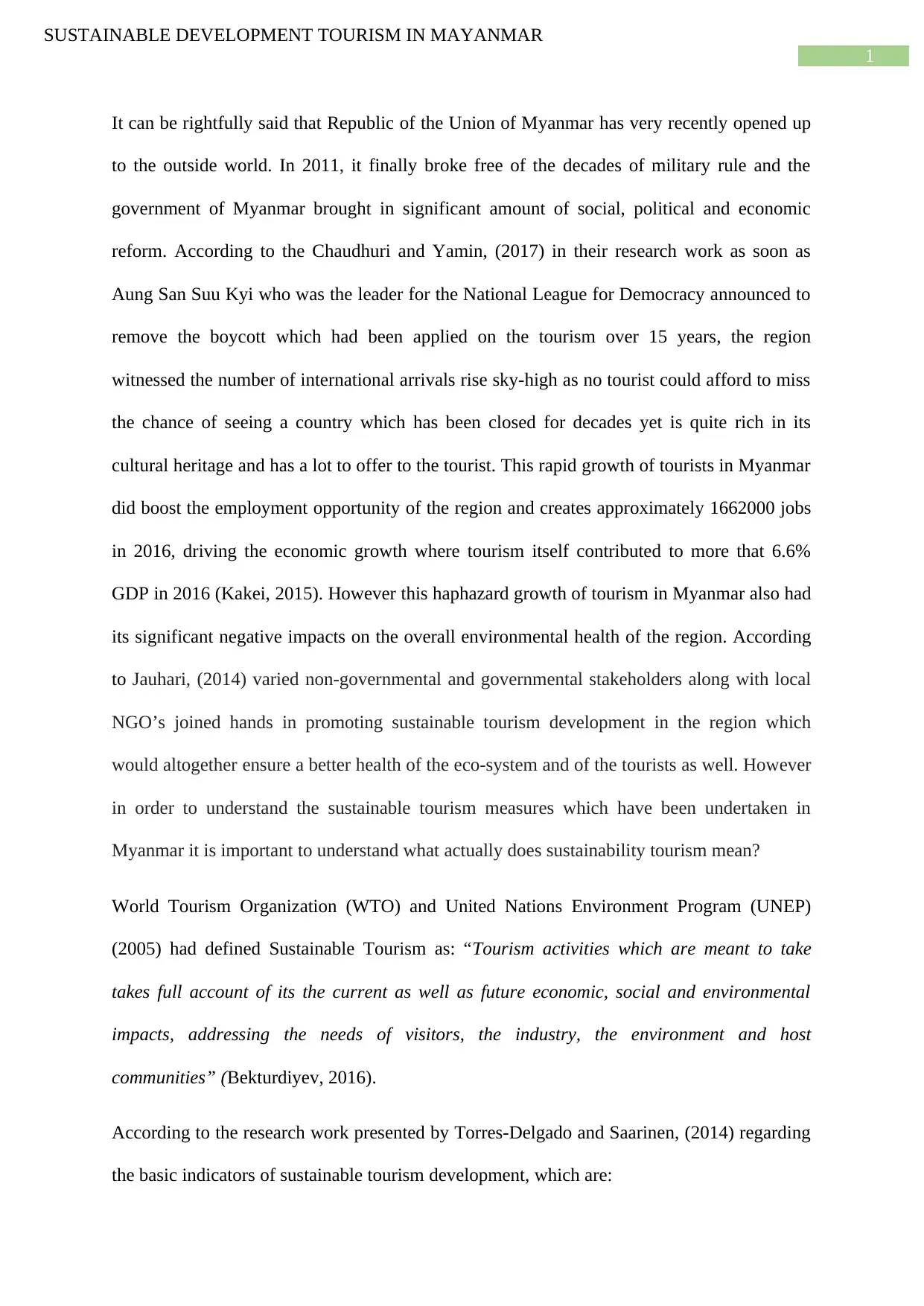
1
SUSTAINABLE DEVELOPMENT TOURISM IN MAYANMAR
It can be rightfully said that Republic of the Union of Myanmar has very recently opened up
to the outside world. In 2011, it finally broke free of the decades of military rule and the
government of Myanmar brought in significant amount of social, political and economic
reform. According to the Chaudhuri and Yamin, (2017) in their research work as soon as
Aung San Suu Kyi who was the leader for the National League for Democracy announced to
remove the boycott which had been applied on the tourism over 15 years, the region
witnessed the number of international arrivals rise sky-high as no tourist could afford to miss
the chance of seeing a country which has been closed for decades yet is quite rich in its
cultural heritage and has a lot to offer to the tourist. This rapid growth of tourists in Myanmar
did boost the employment opportunity of the region and creates approximately 1662000 jobs
in 2016, driving the economic growth where tourism itself contributed to more that 6.6%
GDP in 2016 (Kakei, 2015). However this haphazard growth of tourism in Myanmar also had
its significant negative impacts on the overall environmental health of the region. According
to Jauhari, (2014) varied non-governmental and governmental stakeholders along with local
NGO’s joined hands in promoting sustainable tourism development in the region which
would altogether ensure a better health of the eco-system and of the tourists as well. However
in order to understand the sustainable tourism measures which have been undertaken in
Myanmar it is important to understand what actually does sustainability tourism mean?
World Tourism Organization (WTO) and United Nations Environment Program (UNEP)
(2005) had defined Sustainable Tourism as: “Tourism activities which are meant to take
takes full account of its the current as well as future economic, social and environmental
impacts, addressing the needs of visitors, the industry, the environment and host
communities” (Bekturdiyev, 2016).
According to the research work presented by Torres-Delgado and Saarinen, (2014) regarding
the basic indicators of sustainable tourism development, which are:
SUSTAINABLE DEVELOPMENT TOURISM IN MAYANMAR
It can be rightfully said that Republic of the Union of Myanmar has very recently opened up
to the outside world. In 2011, it finally broke free of the decades of military rule and the
government of Myanmar brought in significant amount of social, political and economic
reform. According to the Chaudhuri and Yamin, (2017) in their research work as soon as
Aung San Suu Kyi who was the leader for the National League for Democracy announced to
remove the boycott which had been applied on the tourism over 15 years, the region
witnessed the number of international arrivals rise sky-high as no tourist could afford to miss
the chance of seeing a country which has been closed for decades yet is quite rich in its
cultural heritage and has a lot to offer to the tourist. This rapid growth of tourists in Myanmar
did boost the employment opportunity of the region and creates approximately 1662000 jobs
in 2016, driving the economic growth where tourism itself contributed to more that 6.6%
GDP in 2016 (Kakei, 2015). However this haphazard growth of tourism in Myanmar also had
its significant negative impacts on the overall environmental health of the region. According
to Jauhari, (2014) varied non-governmental and governmental stakeholders along with local
NGO’s joined hands in promoting sustainable tourism development in the region which
would altogether ensure a better health of the eco-system and of the tourists as well. However
in order to understand the sustainable tourism measures which have been undertaken in
Myanmar it is important to understand what actually does sustainability tourism mean?
World Tourism Organization (WTO) and United Nations Environment Program (UNEP)
(2005) had defined Sustainable Tourism as: “Tourism activities which are meant to take
takes full account of its the current as well as future economic, social and environmental
impacts, addressing the needs of visitors, the industry, the environment and host
communities” (Bekturdiyev, 2016).
According to the research work presented by Torres-Delgado and Saarinen, (2014) regarding
the basic indicators of sustainable tourism development, which are:
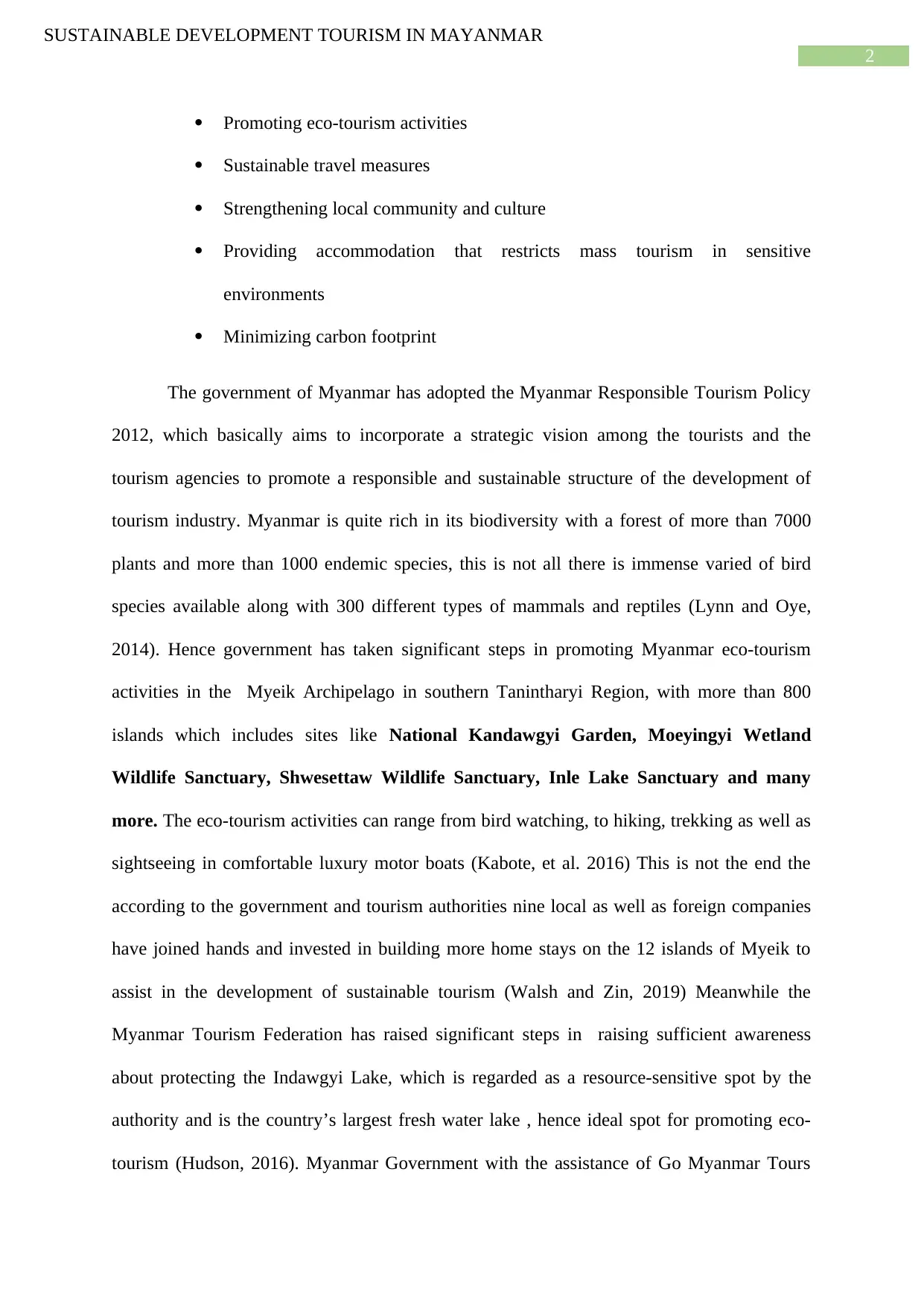
2
SUSTAINABLE DEVELOPMENT TOURISM IN MAYANMAR
Promoting eco-tourism activities
Sustainable travel measures
Strengthening local community and culture
Providing accommodation that restricts mass tourism in sensitive
environments
Minimizing carbon footprint
The government of Myanmar has adopted the Myanmar Responsible Tourism Policy
2012, which basically aims to incorporate a strategic vision among the tourists and the
tourism agencies to promote a responsible and sustainable structure of the development of
tourism industry. Myanmar is quite rich in its biodiversity with a forest of more than 7000
plants and more than 1000 endemic species, this is not all there is immense varied of bird
species available along with 300 different types of mammals and reptiles (Lynn and Oye,
2014). Hence government has taken significant steps in promoting Myanmar eco-tourism
activities in the Myeik Archipelago in southern Tanintharyi Region, with more than 800
islands which includes sites like National Kandawgyi Garden, Moeyingyi Wetland
Wildlife Sanctuary, Shwesettaw Wildlife Sanctuary, Inle Lake Sanctuary and many
more. The eco-tourism activities can range from bird watching, to hiking, trekking as well as
sightseeing in comfortable luxury motor boats (Kabote, et al. 2016) This is not the end the
according to the government and tourism authorities nine local as well as foreign companies
have joined hands and invested in building more home stays on the 12 islands of Myeik to
assist in the development of sustainable tourism (Walsh and Zin, 2019) Meanwhile the
Myanmar Tourism Federation has raised significant steps in raising sufficient awareness
about protecting the Indawgyi Lake, which is regarded as a resource-sensitive spot by the
authority and is the country’s largest fresh water lake , hence ideal spot for promoting eco-
tourism (Hudson, 2016). Myanmar Government with the assistance of Go Myanmar Tours
SUSTAINABLE DEVELOPMENT TOURISM IN MAYANMAR
Promoting eco-tourism activities
Sustainable travel measures
Strengthening local community and culture
Providing accommodation that restricts mass tourism in sensitive
environments
Minimizing carbon footprint
The government of Myanmar has adopted the Myanmar Responsible Tourism Policy
2012, which basically aims to incorporate a strategic vision among the tourists and the
tourism agencies to promote a responsible and sustainable structure of the development of
tourism industry. Myanmar is quite rich in its biodiversity with a forest of more than 7000
plants and more than 1000 endemic species, this is not all there is immense varied of bird
species available along with 300 different types of mammals and reptiles (Lynn and Oye,
2014). Hence government has taken significant steps in promoting Myanmar eco-tourism
activities in the Myeik Archipelago in southern Tanintharyi Region, with more than 800
islands which includes sites like National Kandawgyi Garden, Moeyingyi Wetland
Wildlife Sanctuary, Shwesettaw Wildlife Sanctuary, Inle Lake Sanctuary and many
more. The eco-tourism activities can range from bird watching, to hiking, trekking as well as
sightseeing in comfortable luxury motor boats (Kabote, et al. 2016) This is not the end the
according to the government and tourism authorities nine local as well as foreign companies
have joined hands and invested in building more home stays on the 12 islands of Myeik to
assist in the development of sustainable tourism (Walsh and Zin, 2019) Meanwhile the
Myanmar Tourism Federation has raised significant steps in raising sufficient awareness
about protecting the Indawgyi Lake, which is regarded as a resource-sensitive spot by the
authority and is the country’s largest fresh water lake , hence ideal spot for promoting eco-
tourism (Hudson, 2016). Myanmar Government with the assistance of Go Myanmar Tours
⊘ This is a preview!⊘
Do you want full access?
Subscribe today to unlock all pages.

Trusted by 1+ million students worldwide
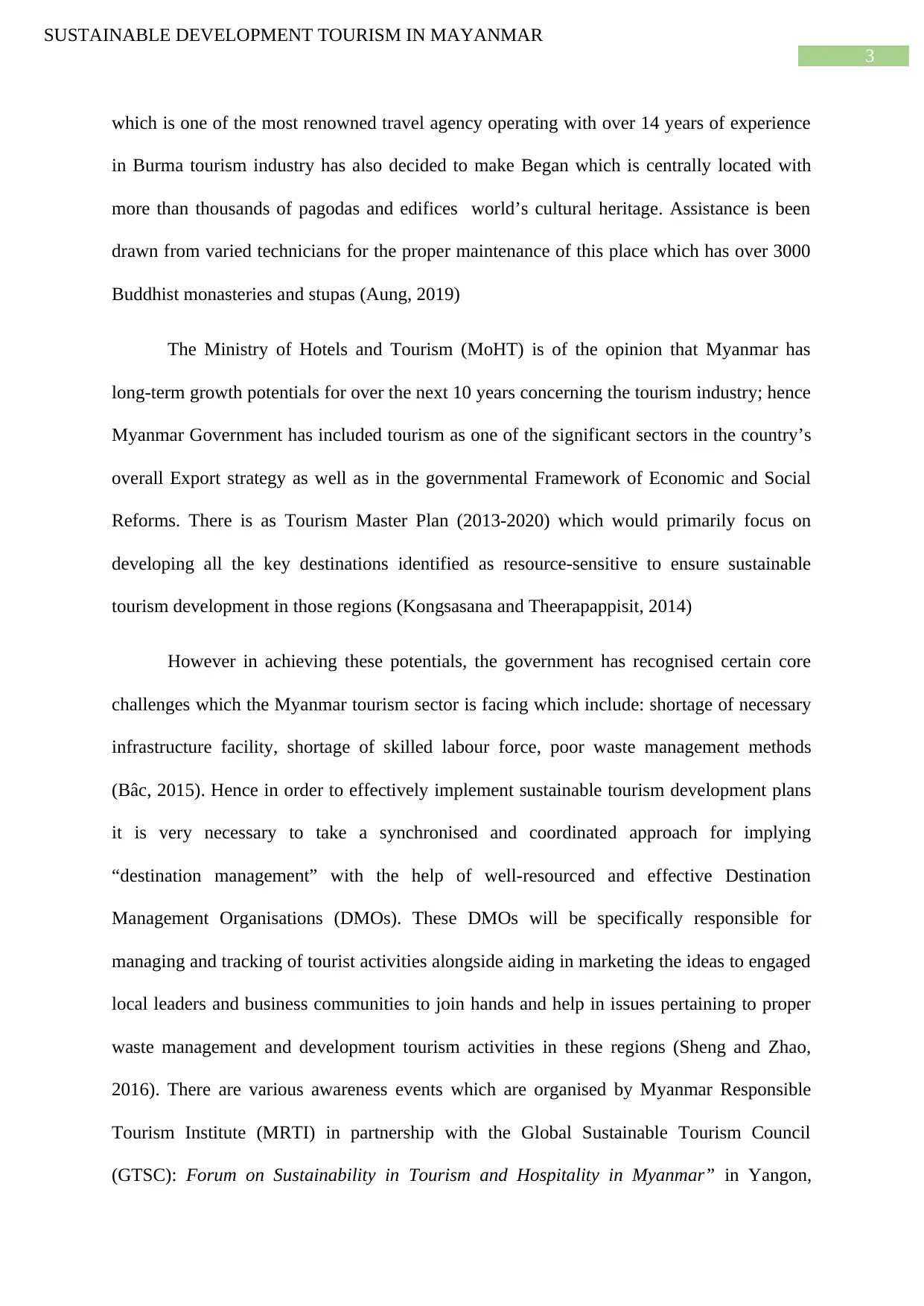
3
SUSTAINABLE DEVELOPMENT TOURISM IN MAYANMAR
which is one of the most renowned travel agency operating with over 14 years of experience
in Burma tourism industry has also decided to make Began which is centrally located with
more than thousands of pagodas and edifices world’s cultural heritage. Assistance is been
drawn from varied technicians for the proper maintenance of this place which has over 3000
Buddhist monasteries and stupas (Aung, 2019)
The Ministry of Hotels and Tourism (MoHT) is of the opinion that Myanmar has
long-term growth potentials for over the next 10 years concerning the tourism industry; hence
Myanmar Government has included tourism as one of the significant sectors in the country’s
overall Export strategy as well as in the governmental Framework of Economic and Social
Reforms. There is as Tourism Master Plan (2013-2020) which would primarily focus on
developing all the key destinations identified as resource-sensitive to ensure sustainable
tourism development in those regions (Kongsasana and Theerapappisit, 2014)
However in achieving these potentials, the government has recognised certain core
challenges which the Myanmar tourism sector is facing which include: shortage of necessary
infrastructure facility, shortage of skilled labour force, poor waste management methods
(Bâc, 2015). Hence in order to effectively implement sustainable tourism development plans
it is very necessary to take a synchronised and coordinated approach for implying
“destination management” with the help of well-resourced and effective Destination
Management Organisations (DMOs). These DMOs will be specifically responsible for
managing and tracking of tourist activities alongside aiding in marketing the ideas to engaged
local leaders and business communities to join hands and help in issues pertaining to proper
waste management and development tourism activities in these regions (Sheng and Zhao,
2016). There are various awareness events which are organised by Myanmar Responsible
Tourism Institute (MRTI) in partnership with the Global Sustainable Tourism Council
(GTSC): Forum on Sustainability in Tourism and Hospitality in Myanmar” in Yangon,
SUSTAINABLE DEVELOPMENT TOURISM IN MAYANMAR
which is one of the most renowned travel agency operating with over 14 years of experience
in Burma tourism industry has also decided to make Began which is centrally located with
more than thousands of pagodas and edifices world’s cultural heritage. Assistance is been
drawn from varied technicians for the proper maintenance of this place which has over 3000
Buddhist monasteries and stupas (Aung, 2019)
The Ministry of Hotels and Tourism (MoHT) is of the opinion that Myanmar has
long-term growth potentials for over the next 10 years concerning the tourism industry; hence
Myanmar Government has included tourism as one of the significant sectors in the country’s
overall Export strategy as well as in the governmental Framework of Economic and Social
Reforms. There is as Tourism Master Plan (2013-2020) which would primarily focus on
developing all the key destinations identified as resource-sensitive to ensure sustainable
tourism development in those regions (Kongsasana and Theerapappisit, 2014)
However in achieving these potentials, the government has recognised certain core
challenges which the Myanmar tourism sector is facing which include: shortage of necessary
infrastructure facility, shortage of skilled labour force, poor waste management methods
(Bâc, 2015). Hence in order to effectively implement sustainable tourism development plans
it is very necessary to take a synchronised and coordinated approach for implying
“destination management” with the help of well-resourced and effective Destination
Management Organisations (DMOs). These DMOs will be specifically responsible for
managing and tracking of tourist activities alongside aiding in marketing the ideas to engaged
local leaders and business communities to join hands and help in issues pertaining to proper
waste management and development tourism activities in these regions (Sheng and Zhao,
2016). There are various awareness events which are organised by Myanmar Responsible
Tourism Institute (MRTI) in partnership with the Global Sustainable Tourism Council
(GTSC): Forum on Sustainability in Tourism and Hospitality in Myanmar” in Yangon,
Paraphrase This Document
Need a fresh take? Get an instant paraphrase of this document with our AI Paraphraser
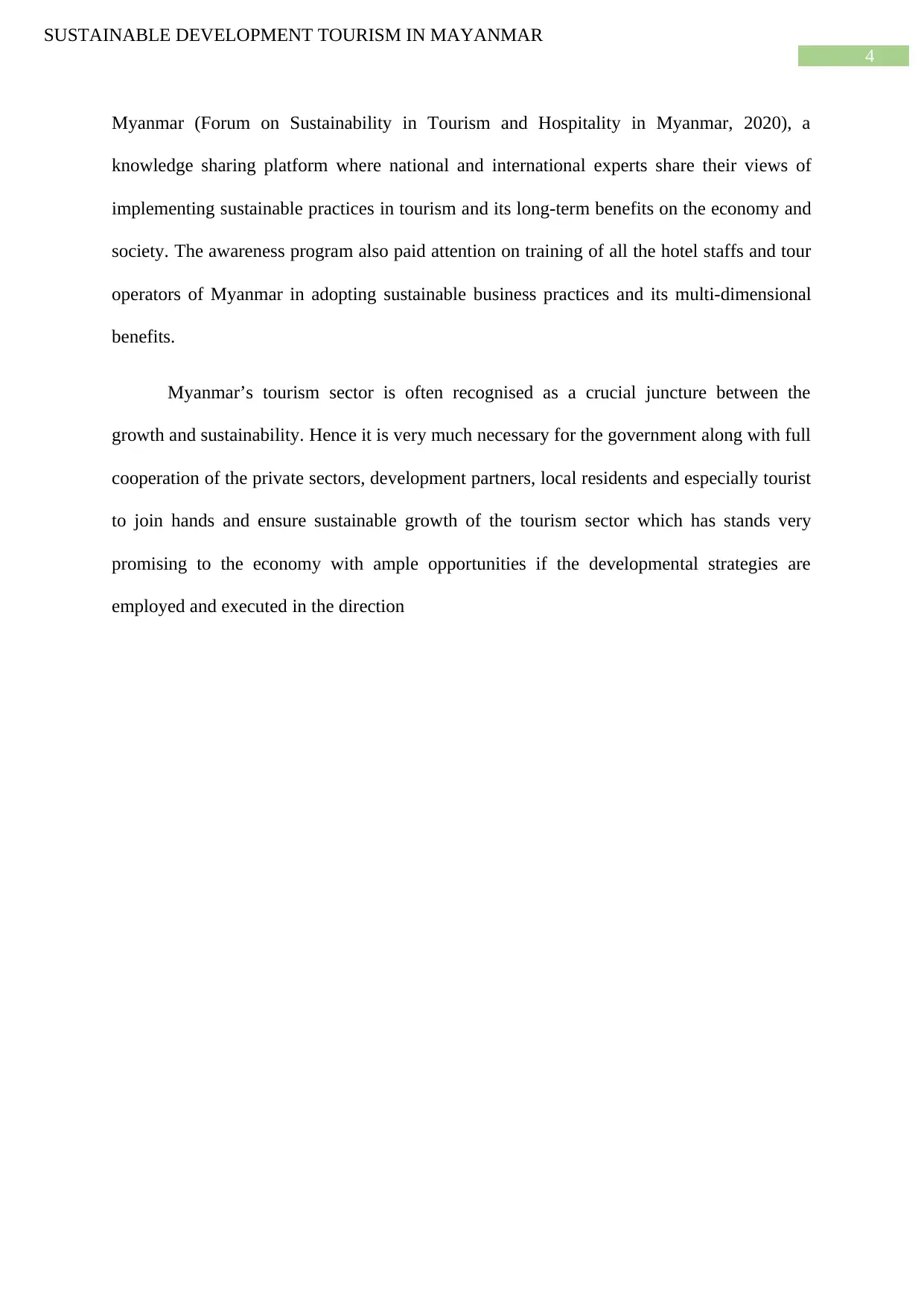
4
SUSTAINABLE DEVELOPMENT TOURISM IN MAYANMAR
Myanmar (Forum on Sustainability in Tourism and Hospitality in Myanmar, 2020), a
knowledge sharing platform where national and international experts share their views of
implementing sustainable practices in tourism and its long-term benefits on the economy and
society. The awareness program also paid attention on training of all the hotel staffs and tour
operators of Myanmar in adopting sustainable business practices and its multi-dimensional
benefits.
Myanmar’s tourism sector is often recognised as a crucial juncture between the
growth and sustainability. Hence it is very much necessary for the government along with full
cooperation of the private sectors, development partners, local residents and especially tourist
to join hands and ensure sustainable growth of the tourism sector which has stands very
promising to the economy with ample opportunities if the developmental strategies are
employed and executed in the direction
SUSTAINABLE DEVELOPMENT TOURISM IN MAYANMAR
Myanmar (Forum on Sustainability in Tourism and Hospitality in Myanmar, 2020), a
knowledge sharing platform where national and international experts share their views of
implementing sustainable practices in tourism and its long-term benefits on the economy and
society. The awareness program also paid attention on training of all the hotel staffs and tour
operators of Myanmar in adopting sustainable business practices and its multi-dimensional
benefits.
Myanmar’s tourism sector is often recognised as a crucial juncture between the
growth and sustainability. Hence it is very much necessary for the government along with full
cooperation of the private sectors, development partners, local residents and especially tourist
to join hands and ensure sustainable growth of the tourism sector which has stands very
promising to the economy with ample opportunities if the developmental strategies are
employed and executed in the direction
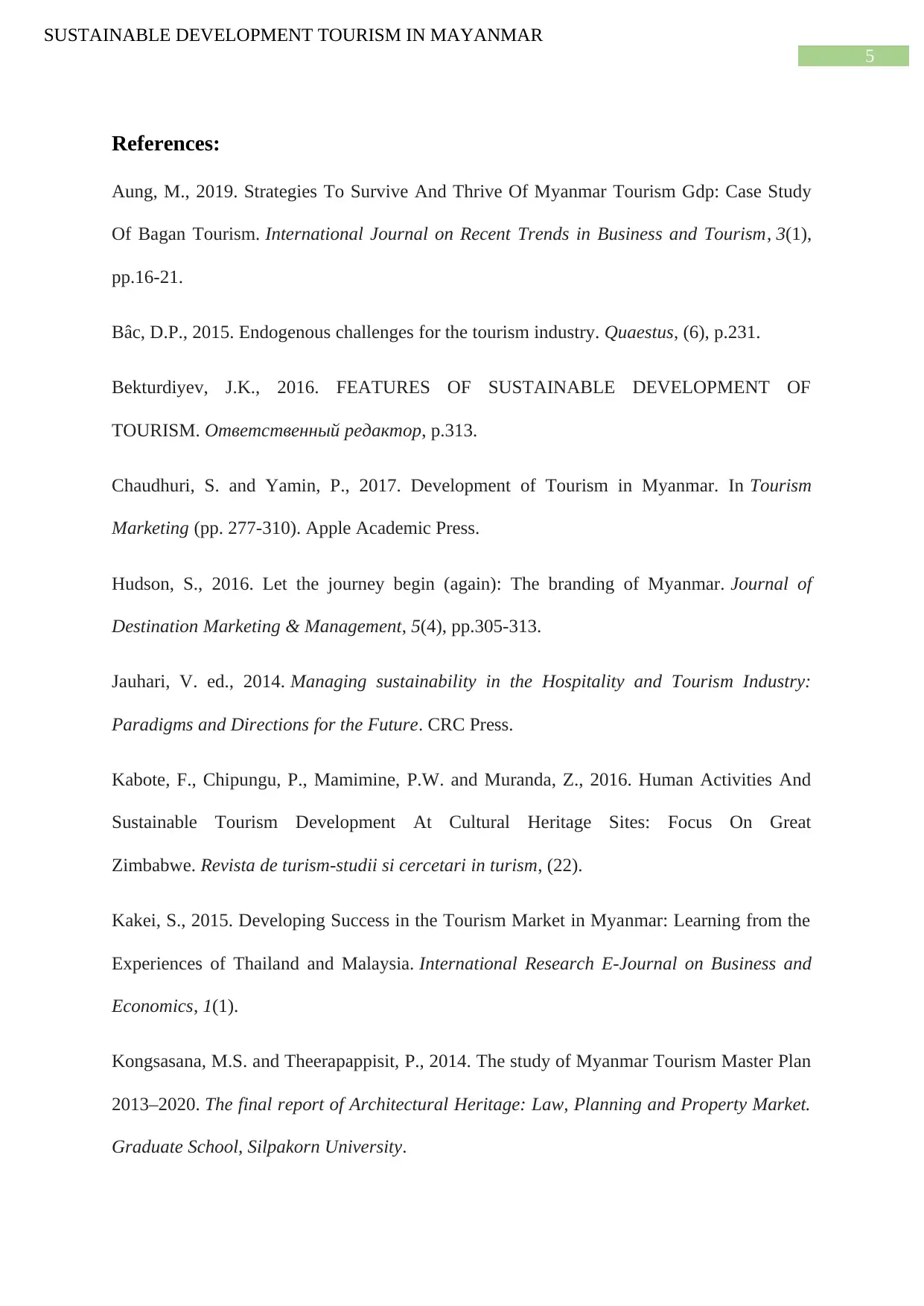
5
SUSTAINABLE DEVELOPMENT TOURISM IN MAYANMAR
References:
Aung, M., 2019. Strategies To Survive And Thrive Of Myanmar Tourism Gdp: Case Study
Of Bagan Tourism. International Journal on Recent Trends in Business and Tourism, 3(1),
pp.16-21.
Bâc, D.P., 2015. Endogenous challenges for the tourism industry. Quaestus, (6), p.231.
Bekturdiyev, J.K., 2016. FEATURES OF SUSTAINABLE DEVELOPMENT OF
TOURISM. Ответственный редактор, p.313.
Chaudhuri, S. and Yamin, P., 2017. Development of Tourism in Myanmar. In Tourism
Marketing (pp. 277-310). Apple Academic Press.
Hudson, S., 2016. Let the journey begin (again): The branding of Myanmar. Journal of
Destination Marketing & Management, 5(4), pp.305-313.
Jauhari, V. ed., 2014. Managing sustainability in the Hospitality and Tourism Industry:
Paradigms and Directions for the Future. CRC Press.
Kabote, F., Chipungu, P., Mamimine, P.W. and Muranda, Z., 2016. Human Activities And
Sustainable Tourism Development At Cultural Heritage Sites: Focus On Great
Zimbabwe. Revista de turism-studii si cercetari in turism, (22).
Kakei, S., 2015. Developing Success in the Tourism Market in Myanmar: Learning from the
Experiences of Thailand and Malaysia. International Research E-Journal on Business and
Economics, 1(1).
Kongsasana, M.S. and Theerapappisit, P., 2014. The study of Myanmar Tourism Master Plan
2013–2020. The final report of Architectural Heritage: Law, Planning and Property Market.
Graduate School, Silpakorn University.
SUSTAINABLE DEVELOPMENT TOURISM IN MAYANMAR
References:
Aung, M., 2019. Strategies To Survive And Thrive Of Myanmar Tourism Gdp: Case Study
Of Bagan Tourism. International Journal on Recent Trends in Business and Tourism, 3(1),
pp.16-21.
Bâc, D.P., 2015. Endogenous challenges for the tourism industry. Quaestus, (6), p.231.
Bekturdiyev, J.K., 2016. FEATURES OF SUSTAINABLE DEVELOPMENT OF
TOURISM. Ответственный редактор, p.313.
Chaudhuri, S. and Yamin, P., 2017. Development of Tourism in Myanmar. In Tourism
Marketing (pp. 277-310). Apple Academic Press.
Hudson, S., 2016. Let the journey begin (again): The branding of Myanmar. Journal of
Destination Marketing & Management, 5(4), pp.305-313.
Jauhari, V. ed., 2014. Managing sustainability in the Hospitality and Tourism Industry:
Paradigms and Directions for the Future. CRC Press.
Kabote, F., Chipungu, P., Mamimine, P.W. and Muranda, Z., 2016. Human Activities And
Sustainable Tourism Development At Cultural Heritage Sites: Focus On Great
Zimbabwe. Revista de turism-studii si cercetari in turism, (22).
Kakei, S., 2015. Developing Success in the Tourism Market in Myanmar: Learning from the
Experiences of Thailand and Malaysia. International Research E-Journal on Business and
Economics, 1(1).
Kongsasana, M.S. and Theerapappisit, P., 2014. The study of Myanmar Tourism Master Plan
2013–2020. The final report of Architectural Heritage: Law, Planning and Property Market.
Graduate School, Silpakorn University.
⊘ This is a preview!⊘
Do you want full access?
Subscribe today to unlock all pages.

Trusted by 1+ million students worldwide
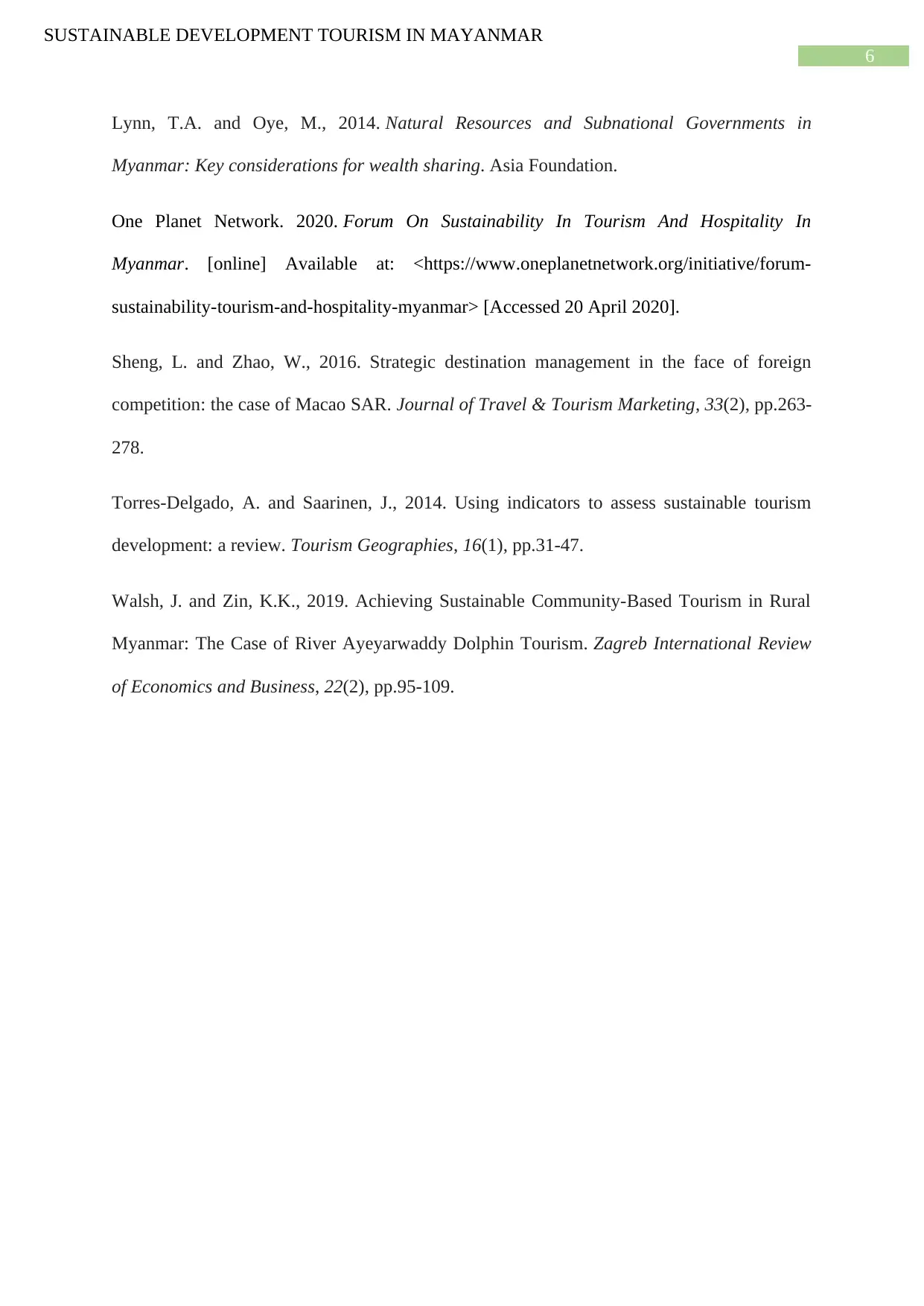
6
SUSTAINABLE DEVELOPMENT TOURISM IN MAYANMAR
Lynn, T.A. and Oye, M., 2014. Natural Resources and Subnational Governments in
Myanmar: Key considerations for wealth sharing. Asia Foundation.
One Planet Network. 2020. Forum On Sustainability In Tourism And Hospitality In
Myanmar. [online] Available at: <https://www.oneplanetnetwork.org/initiative/forum-
sustainability-tourism-and-hospitality-myanmar> [Accessed 20 April 2020].
Sheng, L. and Zhao, W., 2016. Strategic destination management in the face of foreign
competition: the case of Macao SAR. Journal of Travel & Tourism Marketing, 33(2), pp.263-
278.
Torres-Delgado, A. and Saarinen, J., 2014. Using indicators to assess sustainable tourism
development: a review. Tourism Geographies, 16(1), pp.31-47.
Walsh, J. and Zin, K.K., 2019. Achieving Sustainable Community-Based Tourism in Rural
Myanmar: The Case of River Ayeyarwaddy Dolphin Tourism. Zagreb International Review
of Economics and Business, 22(2), pp.95-109.
SUSTAINABLE DEVELOPMENT TOURISM IN MAYANMAR
Lynn, T.A. and Oye, M., 2014. Natural Resources and Subnational Governments in
Myanmar: Key considerations for wealth sharing. Asia Foundation.
One Planet Network. 2020. Forum On Sustainability In Tourism And Hospitality In
Myanmar. [online] Available at: <https://www.oneplanetnetwork.org/initiative/forum-
sustainability-tourism-and-hospitality-myanmar> [Accessed 20 April 2020].
Sheng, L. and Zhao, W., 2016. Strategic destination management in the face of foreign
competition: the case of Macao SAR. Journal of Travel & Tourism Marketing, 33(2), pp.263-
278.
Torres-Delgado, A. and Saarinen, J., 2014. Using indicators to assess sustainable tourism
development: a review. Tourism Geographies, 16(1), pp.31-47.
Walsh, J. and Zin, K.K., 2019. Achieving Sustainable Community-Based Tourism in Rural
Myanmar: The Case of River Ayeyarwaddy Dolphin Tourism. Zagreb International Review
of Economics and Business, 22(2), pp.95-109.
1 out of 7
Related Documents
Your All-in-One AI-Powered Toolkit for Academic Success.
+13062052269
info@desklib.com
Available 24*7 on WhatsApp / Email
![[object Object]](/_next/static/media/star-bottom.7253800d.svg)
Unlock your academic potential
Copyright © 2020–2025 A2Z Services. All Rights Reserved. Developed and managed by ZUCOL.





